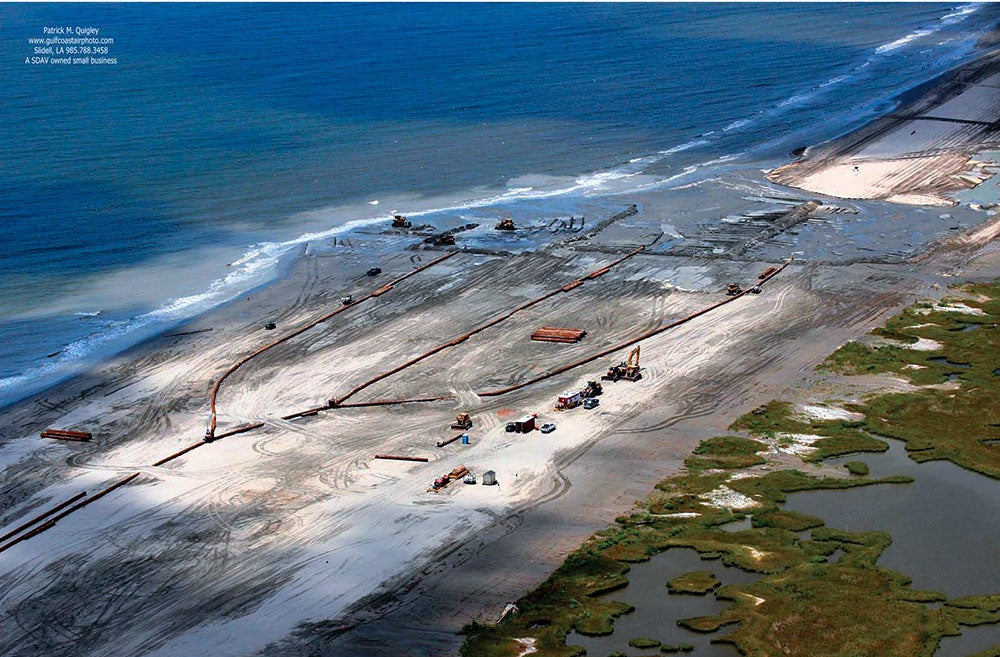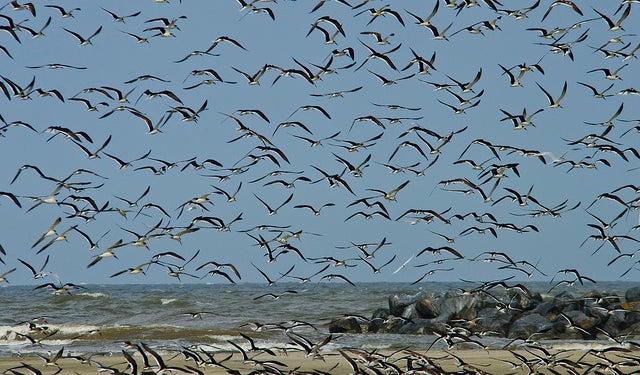Barrier Island Restoration: An Investment in Coastal LA’s Future and for Nesting Seabirds, Part 1
Our partners at Audubon Louisiana published a series of blog posts that we are cross-posting here. View the original blog post here.
As we mark the sixth anniversary of the BP oil spill this week – an event that significantly and negatively impacted Louisiana’s already disappearing barrier islands and the species that depend on them – we will examine the status of barrier island restoration. Over the coming days, we’ll publish a series of blog posts that detail what work has been done to restore Louisiana’s barrier islands, the importance of these islands to birds and humans alike, as well as Audubon Louisiana’s role before, during and after the restoration process to monitor and improve bird health on these islands and elsewhere.
Part 1: “Louisiana Barrier Islands: A Coastal Restoration Success Story”
As you look out into the Gulf of Mexico, off Louisiana’s coastline, are a string of barrier islands. They are remnants of former deltas – as the Mississippi River has flipped and flopped across the southeastern part of state over the last 6,000 years, marshes were created, and eventually eroded away, only leaving behind these sand berms where the river and sea once met. Today, those ancient headland remnants continue to erode, but now the river no longer serves to rebuild them. Sediment that once flowed down the Mississippi River is now either dammed upstream or falls off the edge of the continental shelf at the mouth of the River. Louisiana is in a fight against nature to keep its barrier islands.
Louisiana’s barrier islands were significantly impacted by the 2010 BP oil disaster – six years ago next week– that enveloped them in oil at the height of nesting season and expedited their rate of disappearance. Remember the $4.5 billion dollars BP had to pay in federal criminal penalties? The State of Louisiana received $1.2 billion of that to use toward coastal restoration, and has dedicated it to the development of river diversions to rebuild marsh, as well as the restoration and reconstruction of barrier islands. Many hundreds of millions of dollars from other sources, like CWPPRA, CIAP, and NRDA (to name a few) also support barrier island protection and restoration.

The continued deterioration of Caminada headland threatens thousands of acres of wetland habitat, as well as critical infrastructure. The project creates 300 acres of back barrier marsh and nourishes 130 acres of emergent marsh behind the Caminada beach using material dredged from the Gulf of Mexico. Photo: Patrick M. Quigley, Gulf Coast Air Photo
Since the development of the state’s 2007 Master Plan, Louisiana has reconstructed over 45 miles of barrier islands, and for good reason. Barrier islands are an important infrastructure investment in coastal Louisiana. They help protect marshes and human communities from storm surges and hurricanes.
Barrier islands also play a critical role in the life cycle of dozens of migratory shorebirds and breeding seabirds. Louisiana, at the base of the Mississippi Flyway and with the Mississippi River Delta central to the Gulf of Mexico, supports astoundingly high proportions of regional or global populations of many coastal nesting species of conservation concern. Many of these species largely depend on barrier islands for nesting, including Brown Pelicans, Tricolored Herons, Sandwich Terns, Royal Terns and Black Skimmers. Coastal Louisiana’s shorelines and barrier islands also support important stopover and wintering habitat for a substantial proportion of Great Plains Piping Plovers, hendersoni Short-billed Dowitchers and western Willets, as well as many other species of sandpiper and plover.

Black Skimmers in Grand Isle, La Photo: Erik Johnson, Audubon Louisiana
Up next, we’ll get into the specifics of why barrier islands are so important to birds.